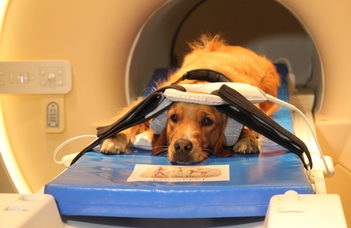Dog brains can detect who is talking

Using functional MRI on awake dogs, researchers at the MTA-ELTE ‘Lendület’ Neuroethology of Communication Research Group and Department of Ethology, Eötvös Loránd University (ELTE), Hungary showed that dog brains are more efficient at detecting who is talking to them than what speech sounds they say. They discovered that dogs use a similar brain region as humans to analyze speaker identity. Remarkably, however, the neural activity pattern during this speaker identity analysis is just the opposite in dogs and humans. The study will be published on the 4th of March in Scientific Reports.
“Dogs live surrounded by human speech and we know that they react to human communicative signals very efficiently. But we just began to understand what dog brains can make out of human speech” – Marianna Boros, postdoctoral researcher at the MTA-ELTE ‘Lendület’ Neuroethology of Communication Research Group, lead author of the study explains. “Human speech contains various types of information, from emotions to speech sounds and voice identities. If we reveal the similarities and differences in how dogs and humans analyze speech, we will better understand how the various aspects of speech perception emerged during human evolution.”
To reveal which regions of the dog brain are tuned to detect who is speaking and what speech sounds they say, researchers performed two functional magnetic resonance imaging (fMRI) experiments with awake, cooperating, specially trained dogs. During brain scanning, dogs listened to sequences of short nonsense words. In the first experiment, words were either repeated by the same person or by many different persons. In the second experiment, words were either exactly the same or they differed in a single vowel. This so called repetition paradigm has never been used in dogs before, but it is often used in human research to study what differences a certain brain region can detect. For example, when we hear the same sound again and again, this repetition causes a neural activity change in the auditory cortex.
The two experiments had different results. For speaker processing, there was a repetition effect in neural activity in the dog auditory brain, but there was no such repetition effect for speech sound processing. Interestingly, this repetition effect for speaker processing was found not in the early neural stages of sound processing, but in the so called secondary auditory cortex, a region that is believed to process higher-level auditory information. Previous studies found similar brain regions for speaker processing in both humans and monkeys.
Surprisingly, however, the way repetition affected the dog brain was opposite to what the researchers expected. In humans, there is typically a decrease in brain activity when words are repeated by the same speaker. But here, dogs’ brain activity increased when they heard the same speaker over and over again. “Such repetition enhancement is typically seen when the brain is building new representations. Because humans encounter many different voices, they probably have a rich repertoire of voice representations. In this so called voice space newly heard voices can be compared to the existing representations and there is no need to build new ones. We don’t know if dogs have such a voice space. If they do not, then they must first build a representation for every new voice they hear. This may be the reason why we see neural activity increase for voice repetitions in dogs — we hope to explore this possibility in our next studies” – Boros explains.
And why can it be that there was no repetition effect for speech sound processing in the dog brain? Is this because dogs do not hear the difference between speech sounds? Perhaps not. It is more probable that dogs are more efficient at analyzing who is speaking than what speech sounds they say.
“We already knew from our previous dog fMRI studies that dog brains detect whether speech contains meaningful words or not, and the emotions in our voice. This new research provides the first evidence that dog brains also encode who is speaking to them” – says Attila Andics, principal investigator of the MTA-ELTE ‘Lendület’ Neuroethology of Communication Research Group.
This research was published in Scientific Reports titled Repetition enhancement to voice identities in the dog brain. This research was funded by the Hungarian Academy of Sciences (’Lendület’ Program), the European Research Council (ERC), the Ministry of Human Capacities, the Hungarian Scientific Research Fund and the Eötvös Loránd University (ELTE).
link to the article: http://www.nature.com/articles/s41598-020-60395-7

